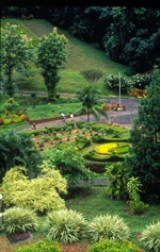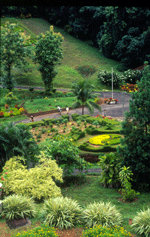
Tropical Botanical Garden and Research Institute
Encyclopedia
Tropical Botanical Garden and Research Institute (TBGRI) is an autonomous Institute established by the Government of Kerala on 17 November 1979 at Trivandrum, the capital city of Kerala. It functions under the umbrella of the Science, Technology and Environment Department, Government of Kerala. The Royal Botanic Gardens (RBG), Kew played an exemplary and significant role in shaping and design of garden lay out of TBGRI in its formative stages.
 The Institute does research in conservation biology, Biotechnology
The Institute does research in conservation biology, Biotechnology
, Plant Taxonomy, Microbiology, Phytochemistry, Ethnomedicine and Ethophamacology,which are the main areas considered to have immediate relevance to the development of the garden. While taxonomists prepared a flora of the garden documenting the native plant wealth before mass introduction and face lift which subsequently followed, the bio-technologists mass multiplied plants of commercial importance, especially orchids for cultivation and distribution to the public.
TBGRI makes a comprehensive survey of the economic plant wealth of Kerala, to conserve, preserve and sustainably utilise the plant wealth. The institute carry out botanical, horticultural and chemical research for plant improvement and utilization; and offer facilities for the improvements of ornamental plants and to propagate them in the larger context of establishment of nursery and flower trade. The cultivation and culturing of plants of India/other countries with comparable climatic condition for the economic benefit of Kerala/India is also taken care. Activities to help botanical teaching and to create public understanding of the value of plant research is initiated by TBGRI. TBGRI gardens medicinal plants, ornamental plants and various introduced plants of economic or aesthetic value. TBGRI also seves as a source of supply of improved plants which are not readily available from other agencies.
Scientific researches on plant wealth are pursued through the following Divisions:
1. Garden Management, Education, Information and Training
2. Plant Genetic Resources
3. Biotechnology and Bioinformatics
4. Conservation Biology
5. Ethnomedicine and Ethnopharmacology
6. Phytochemistry and Phytopharmacology
7. Plant Systematics and Evolutionary Sciences

Biotechnology
Biotechnology is a field of applied biology that involves the use of living organisms and bioprocesses in engineering, technology, medicine and other fields requiring bioproducts. Biotechnology also utilizes these products for manufacturing purpose...
, Plant Taxonomy, Microbiology, Phytochemistry, Ethnomedicine and Ethophamacology,which are the main areas considered to have immediate relevance to the development of the garden. While taxonomists prepared a flora of the garden documenting the native plant wealth before mass introduction and face lift which subsequently followed, the bio-technologists mass multiplied plants of commercial importance, especially orchids for cultivation and distribution to the public.
TBGRI makes a comprehensive survey of the economic plant wealth of Kerala, to conserve, preserve and sustainably utilise the plant wealth. The institute carry out botanical, horticultural and chemical research for plant improvement and utilization; and offer facilities for the improvements of ornamental plants and to propagate them in the larger context of establishment of nursery and flower trade. The cultivation and culturing of plants of India/other countries with comparable climatic condition for the economic benefit of Kerala/India is also taken care. Activities to help botanical teaching and to create public understanding of the value of plant research is initiated by TBGRI. TBGRI gardens medicinal plants, ornamental plants and various introduced plants of economic or aesthetic value. TBGRI also seves as a source of supply of improved plants which are not readily available from other agencies.
Scientific researches on plant wealth are pursued through the following Divisions:
1. Garden Management, Education, Information and Training
2. Plant Genetic Resources
3. Biotechnology and Bioinformatics
4. Conservation Biology
5. Ethnomedicine and Ethnopharmacology
6. Phytochemistry and Phytopharmacology
7. Plant Systematics and Evolutionary Sciences
The major achievements of TBGRI at a glance
- Developed a modern conservatory garden for ex-situ conservation of plants and scientific studies for sustainable utilization.
- Established large living collection of trees and woody lianas (1000 species); Medicinal, Aromatic and Spice plants (1500 species), Orchids (600 species and 150 hybrids); Bamboos (60 species); Rare and Threatened plants( 550 species); Ferns and Fern allies ( 165 species); Palms (105 species), Cycads ( 35 species) and special groups like Zingibers ( 50 species), Bougainvillea, Aquatic plants, Insectivorus plants, Wild ornamentals, Wild Balsams, Jasmines, Begonias, Strobilanthes, Water lillies etc. for conservation, display and education. The living collections of trees, bamboos, orchids, Medicinal Aromatic and spice plants are the largest in South Asia.
- Established a National Gene Bank for Medicinal and aromatic plants including a Meristem Bank, Seed Bank, Cryo Bank and a Field Gene Bank under the aegis of the Department of Biotechnology, Government of India.
- Discovered family Lembosiaceae, genus Xanthagaricus of foliicolous fungi.
- Discovered the genera Seidenfadeniella (2 species), Sivadasania (1 species) and over 100 species of flowering plants and discovered 40 species of flowering plants, believed to be extinct in the wild.
- Undertaken studies on reproductive biology of selected RET trees, balsams, bamboos and orchids to evolve strategies for their effective conservation.
- Produced 15 new orchid and bamboo hybrids having horticultural potential.
- Introduced and evaluated 150 species of native plants based on their ornamental and landscape potential.
- Recognized by Ministry of Environment and Forests (MoEF), Government of India as a lead institution for Biosphere programme and Centre for Research on orchids.
- Maintaining a herbarium of Kerala Flora comprising 51,104 specimens (as per 2006 records), catering to the needs of students, researchers and scientists.
- Developed tissue culture protocols for rapid multiplication of orchids, medicinal plants, bamboos and rattans leading to reintroduction and restoration of many of them.
- Chemical profile and DNA finger printing of medicinal plants are going on.
- Established a Bioinformatic Centre under DBT-BTIS programme of Government of India particularly focused the biological resources of Kerala.
- Prepared a database on the Flora of Kerala.
- Transferred the production technology of Jeevani (an immuno-enhancing, antifatigue, anti stress and hepatoprotective herbal drugs) and SISAIROSP ( a herbal formulation to control psoriasis and dandruff) for commercial manufracture.
- Developed 12 new phytomedicine and filed 15 patents.
- Published 25 books, 1000 research papers, 20 handouts/bulletins/course materials
- Carried out Environmental Impact Assessment Studies (EIA) on different hydroelectric projects and offered Environmental Management Plan to KSEB to take up various protective measures for safequarding the biodiversity.
- TBGRI model recognized world's first ever model to benefit sharing.
The objectives of TBGRI
- To carry out botanical, horticultural and chemical research for plant improvement and utilization.
- To organize germplasmGermplasmA germplasm is a collection of genetic resources for an organism. For plants, the germplasm may be stored as a seed collection or, for trees, in a nursery.-See also:*Germ plasm, the germ cell determining zone...
collections of economic plants of interest to the state in the case of those speciesSpeciesIn biology, a species is one of the basic units of biological classification and a taxonomic rank. A species is often defined as a group of organisms capable of interbreeding and producing fertile offspring. While in many cases this definition is adequate, more precise or differing measures are...
for which separate centers are not already in existence. - To establish a model production center for translating the fruits of research to public advantage leading to plant-based industrial ventures.
- To establish an arboretum in approximately half the area of the Garden, with representative specimens of trees of Kerala and India, and trees of economic value from other tropical areas of the world.
- To prepare a floraFloraFlora is the plant life occurring in a particular region or time, generally the naturally occurring or indigenous—native plant life. The corresponding term for animals is fauna.-Etymology:...
of KeralaKeralaor Keralam is an Indian state located on the Malabar coast of south-west India. It was created on 1 November 1956 by the States Reorganisation Act by combining various Malayalam speaking regions....
. - To establish tissue cultureTissue cultureTissue culture is the growth of tissues or cells separate from the organism. This is typically facilitated via use of a liquid, semi-solid, or solid growth medium, such as broth or agar...
facility with special reference to the improvement of seeds/fruits/flowers and quick and easy propagationPlant propagationPlant propagation is the process of creating new plants from a variety of sources: seeds, cuttings, bulbs and other plant parts. Plant propagation can also refer to the artificial or natural dispersal of plants.-Sexual propagation :...
. - To be engaged in gardenGardenA garden is a planned space, usually outdoors, set aside for the display, cultivation, and enjoyment of plants and other forms of nature. The garden can incorporate both natural and man-made materials. The most common form today is known as a residential garden, but the term garden has...
planning and research. - To do chemical screening of plants of potential medicinal importance.
- To work in collaboration with similar institutes in IndiaIndiaIndia , officially the Republic of India , is a country in South Asia. It is the seventh-largest country by geographical area, the second-most populous country with over 1.2 billion people, and the most populous democracy in the world...
and outside - To promote and establish modern scientific research and development studies relating to plants of importance to IndiaIndiaIndia , officially the Republic of India , is a country in South Asia. It is the seventh-largest country by geographical area, the second-most populous country with over 1.2 billion people, and the most populous democracy in the world...
and to KeralaKeralaor Keralam is an Indian state located on the Malabar coast of south-west India. It was created on 1 November 1956 by the States Reorganisation Act by combining various Malayalam speaking regions....
in particular.
External links
- Department of Biotechnology, Government of India
- Rajiv Gandhi Centre for Biotechnology, Trivandrum

